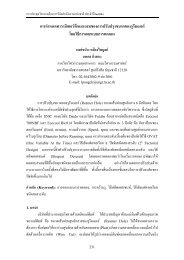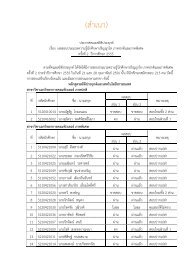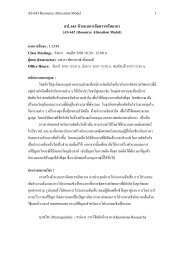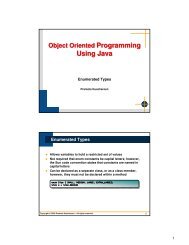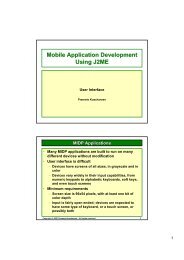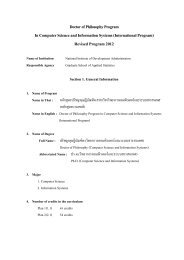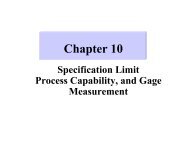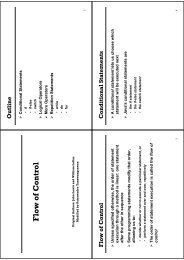ดาวน์โหลด All Proceeding - AS Nida
ดาวน์โหลด All Proceeding - AS Nida
ดาวน์โหลด All Proceeding - AS Nida
Create successful ePaper yourself
Turn your PDF publications into a flip-book with our unique Google optimized e-Paper software.
Fig. 1 Swap operator and Adjustment operator on the 2 nd and 4 th<br />
position<br />
2.1.2 Genetic Algorithm 2 (GA2)<br />
The second approach of GA was presented by<br />
Rungrattanaubol and Na-udom [6]. For the sake of completeness, we<br />
describe the steps of GA as follows and visualized in Fig. 2.<br />
Step 1: Initial population<br />
Generate m random LHD of order n× d . The initial<br />
population comprises of these m { X<br />
i<br />
; i = 1,2, K , m}<br />
LHD.<br />
Step 2: Let population P be{ X<br />
i<br />
; i = 1,2, K , m}<br />
, sort LHD with<br />
respect to the optimality criterion.<br />
Step 3: Selecting parents<br />
Randomly select two LHD from the sequence in Step 1, say<br />
X<br />
a and X<br />
b . Next randomly select one column from each of the<br />
LHD's say Ca and Cb .<br />
Step 4: Generating offspring column<br />
Once the column Ca and Cb are selected. Two new<br />
offspring column a<br />
O and b<br />
O can be obtained as follows.<br />
• Identify rows in each column having identical elements,<br />
copy identical elements in the same row position in<br />
column a<br />
O and b<br />
O .<br />
• Select two row positions, q to r , copy all elements of<br />
column Ca from position q to r in offspring<br />
column a<br />
O . Similarly copy the contents of column<br />
C b from position q to r in offspring b<br />
O .<br />
77<br />
a<br />
O in sequence of<br />
occurrence in column Cb . Similarly assign the<br />
remaining entries in column O<br />
b in sequence of<br />
occurrence in column Ca .<br />
• Assign remaining entries in column<br />
Step 5: Generating offspring LHD<br />
Randomly select a column from each parents LHD<br />
X<br />
a and X<br />
b and replace it by a<br />
O . Repeat this process again, this<br />
time replace randomly selected column by b<br />
O . This process will<br />
result in 4 new LHD's.<br />
Step 6: Repeat steps 3, 4 and 5 till at least mi new offspring LHD's<br />
are generated.<br />
Step 7: Perform mutations on the collection of m i LHD's obtained in<br />
Step 6 using adjustment operator as follows<br />
• Randomly select a column for mutation with<br />
probabilityω .<br />
• Perform mutation on the selected columns by randomly<br />
selecting<br />
• two points in the column, say s and t , and replacing the<br />
substring between these points by its cyclic permutation.<br />
Step 8: Sort the LHD's generated in Step 7, and retain best m − 2 with<br />
respect to an optimality criterion, say { X<br />
*<br />
i : i = 1,2, K , m−2}.<br />
Select two best LHD with respect to optimal criterion in Step 2 and set<br />
these as X<br />
*<br />
,<br />
*<br />
m− 1 Xm<br />
. The new generation comprises of these m<br />
LHD's ({ X<br />
*<br />
: i 1,2, , m}).<br />
i = K<br />
K<br />
*<br />
K , repeat<br />
Step 9: Set { Xi; i = 1, 2, , m} ≡ { Xi ; i = 1, 2, , m}<br />
Step (2-8) if the stopping criteria as described below is not attained.<br />
Otherwise stop the search and report best LHD in the generation with<br />
respect to an optimality criterion.<br />
As described above, there are four cases of GA will be<br />
investigated in this paper, GA1 with SO, GA1 with AO, GA2 with SO<br />
and GA2 with AO, respectively.




